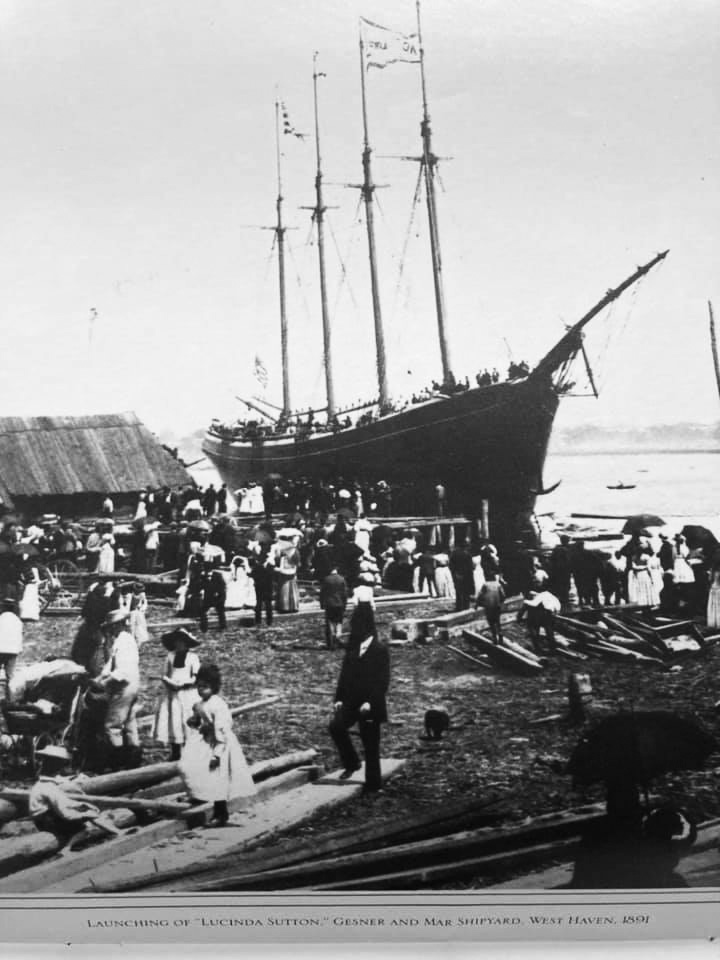
By Dan Shine
Voice Columnist
Maritime Series, Part I
See part 2 | part 3 | part 4 | part 5 | part 6 | part 7
New Haven Harbor: In 1614, Dutch Explorer Adriaen Block visited and mapped the Connecticut shoreline; he named the place “Roodberg” (Red Hills) for West Rock and East Rock. The Indians of that area called it “Quinnipiac,” and named themselves after it. The first English settlers would name it their New Haven. This would ultimately become the third busiest harbor in New England.
The harbor is an estuary that is more than four miles wide, and is fed by the Mill River, the Quinnipiac River, the West River, and a number of smaller tributaries. The first European settlers chose this harbor as a place where they could establish an important commercial center, and trade with the West Indies and Europe. However, the harbor was shallow, and the long channel—initially only seven feet deep at mean low water—was hard to negotiate, even with the ships of the 1600s. Centuries of improvements and enhancements would follow.
As part of its natural development, West Haven has been tied to the sea, even back into pre-history; here follows the first part of a series, covering different aspects of that multifaceted relationship.
Gesner & Mar Shipyard
Why is he there? A visitor to Savin Rock might wonder why a statue of a lone sailor stands at the edge of the Old Grove.
It is a fact that West Haveners have a long and proud history of service to the Port of New Haven. Back in the late 1800s, many an enterprising eleven, or twelve-year-old youth would begin working as a ship’s boy on one of the many coastal sloops that sailed from New Haven. Within a few years, the boy would have acquired the skills necessary to become a seaman of considerable worth. By the time he had reached the age of twenty or twenty-two, the young man might use his savings to purchase shares in a local sloop and in that way become her captain.
Although New Haven would never become a great international port, it served the East Coast, all the way from northern Maine down to the Caribbean. During the late 1800s, New Haven Harbor was a busy and exciting place. On a typical day, one hundred sailing ships crowded the docks, as an equal number sat at anchor in the harbor, waiting for a favorable wind and tide. As unreal as it may seem, it has been stated that in 1895, about 31,000 vessels entered New Haven Harbor; of that number, 9,000 were still under sail, and over 8,000 were barges.
New Haven’s needs for a multitude of sailing vessels were well served by several Fair Haven boatyards, which were located in the vicinity of the Tomlinson Bridge and near the site of the present Union Station.

In 1861, W.M. Gesner, a shipbuilder from Fair Haven established a shipyard at the corner of Water Street and Main 000Street in West Haven. In 1865, Gesner took in his brother-in-law, John E. Mar as a partner, and the business became known as Gesner & Mar Shipyard. From 1880 to 1893, the shipyard had two shipways and had become the most important industry in town; there they built three and four-masted schooners, as well as steamships. So closely did our community identify with the sea during this period, that the tall flagpole on the Green was actually the mast and spar removed from a ship that was being overhauled at the shipyard.
Naturally the existence of a shipbuilding company in West Haven created a strong demand for local timber, which was gradually depleted. With the advent of steamships, local shipbuilding began to decline, as local companies turned instead to barge construction and repairing and refitting of pleasure craft. Clearly for Gesner & Mar, the handwriting was on the wall.
Records indicate that the last commercial sailing vessel, the Lucinda K. Sutton, was launched from the Gesner & Mar Shipyard in 1891. Picnics, bands, and an air of excitement accompanied the launching. However the event was poorly planned: the vessel slid down the ways at low tide, and instead of floating away, it became stuck in the mud—the event’s sad ending capped the even sadder ending of the Gesner & Mar business.
In later years, records indicate that the shipyard was taken over by Ruben Green and called Green’s Shipyard. When that business failed, the Yale Flying-boat Service took over the site in the 1920s, and engaged in the construction and repair of seaplanes. In the 1930s and 40s, the business on that site was known as West Haven Shipyard, Inc. Until recently, it was the site of the Bilco Company. And along the water’s edge, a row of rotting pilings bears mute testimony to an industry what once was.
It is difficult for us in these times to imagine a day when workmen walked to the shipyard each morning, over the dirt streets of West Haven; there they performed their labors in a place where great wooden ships with hundred-foot masts towered over the nearby homes, and much of the community relied on the sea for its livelihood. Today, and all that stands as a visible reminder of those times is the enigmatic statue of The Lone Sailor.